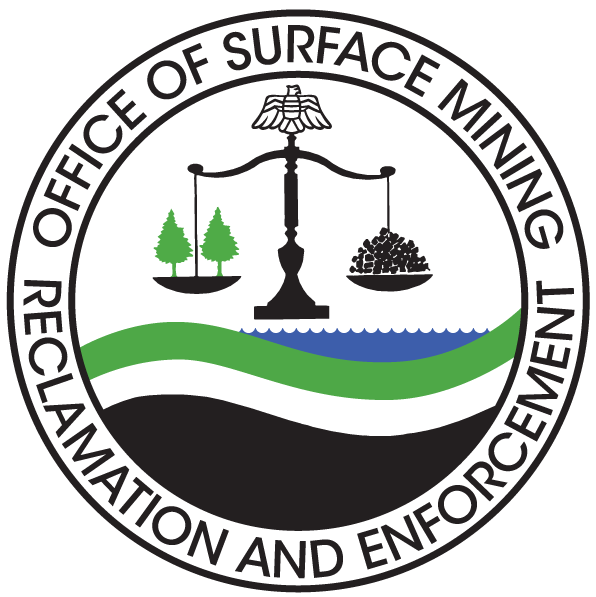Chronology of Major SMCRA-Related Events
This unofficial chronology lists major events related to the Surface Mining Control and Reclamation Act of 1977.
An unofficial version of the Surface Mining Control and Reclamation Act of 1977 as amended is available from www.govinfo.gov (PDF download).
The Code of Federal Regulations (CFR) contains the rules that agencies use to accomplish their missions. The Office of the Federal Register publishes annual updates of the CFR and maintains an up-to-date electronic version of OSMRE's rules at this link:
The CFR contains only the text of the rules themselves. To better understand the background of a particular rule, you may wish to review the preamble to that rule as published in the Federal Register.
President Carter signs SMCRA into law. The Act establishes the Office of Surface Mining Reclamation and Enforcement within the Department of the Interior to carry out the provisions of the law. SMCRA was the first federal environmental statute to regulate a specific industry as opposed to a specific type of pollution. It created two major programs:
- An abandoned mine land (AML) reclamation program, funded by fees that operators pay on each ton of coal produced, to reclaim land and water resources adversely affected by coal mines abandoned before August 3, 1977.
- A regulatory program to ensure that surface coal mining operations initiated or in existence after the effective date of the Act are conducted and reclaimed in an environmentally sound manner.
Congress first held hearings on surface coal mining regulation in 1968.
Two bills passed in 1974 and 1975 were vetoed.
Initial regulatory program regulations published along with regulations governing assessment and collection of reclamation fees.
OSMRE publishes final rules for administration of the abandoned mine land reclamation program.
OSMRE publishes final rules for the permanent regulatory program.
First annual Excellence in Surface Coal Mining and Reclamation Awards presented to mine operators.
Public Law 100-71 authorizes the Navajo, Hopi, and Crow Tribes to administer abandoned mine land reclamation programs on Indian lands without first having approved regulatory programs. The tribes subsequently obtain approval of their AML reclamation plans between May 1988 and January 1989.
The Applicant/Violator System (AVS) becomes operational. The AVS is an automated database and information system into which OSMRE and the state regulatory authorities enter information on applicants, permittees, operators, application and permit records, as well as unabated or uncorrected violations. The primary purpose of the AVS is to assist OSMRE and the states in making permit eligibility determinations under section 510(c) of SMCRA.
First prototype of Technical Information Processing workstations installed in Montana, Illinois, and Pennsylvania. The TIPS (Technical Innovation and Professional Services) program has since become one of the most effective tools available to all states to analyze and make informed decisions on permit applications.
The Energy Policy Act of 1992 becomes law. Among other things, this act requires that underground mine operators replace drinking, domestic, and residential water supplies damaged by underground mining after this date and correct subsidence damage to occupied residential and noncommercial structures caused by underground mining operations conducted after this date.
Title II, Surface Mining Control and Reclamation Act Amendments of 2006 in the Tax Relief and Health Care Act of 2006 (Public Law 109-432) substantially overhauled the AML reclamation program by, among other things, extending reclamation fee collection through September 30, 2021, at incrementally reduced rates, requiring Treasury payments to certified states and tribes in lieu of payments from the AML Fund, providing a permanent appropriation for disbursements from the AML Fund, and requiring allocation of disbursements from the AML Fund on the basis of historic coal production. The law greatly increased the funds available for reclamation of AML problems and the flexibility that states and tribes have in using those funds.
The law also amended SMCRA to allow Indian tribes to achieve primacy for the regulation of all or part of surface coal mining operations conducted on reservation lands.
The Infrastructure Investment and Jobs Act P.L. 117-58 was enacted on November 15, 2021. This enacted legislation included language that directly, or in some cases indirectly, impacted OSMRE. In addition to the extension of abandoned mine land (AML) fee collections and mandatory AML Grant distributions, $11.293 billion in new funding was authorized to be appropriated for deposit into the Abandoned Mine Reclamation Fund. The authority to collect the Title IV AML reclamation fee expires September 30, 2034 under the law. Fee rates for all coal sold, transferred, or used on or after October 1, 2021, are:
- Surface-mined coal (except lignite) – 22.4 cents per ton
- Underground-mined coal (except lignite) – 9.6 cents per ton
- Lignite – 6.4 cents per ton
- The alternative Ad-Valorem rate of 10 percent of the value for surface or underground and 2 percent of the value for lignite, continues to be in effect.

